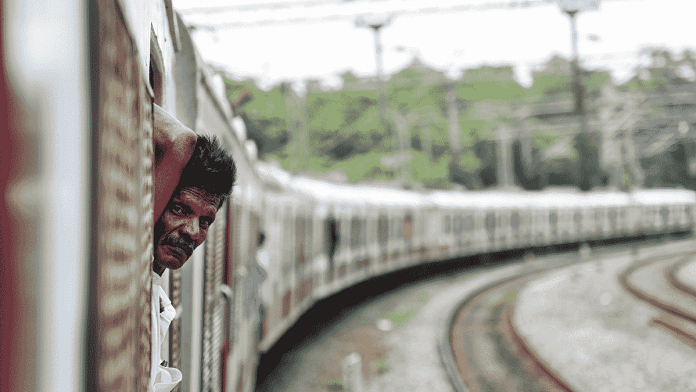New Delhi: With the devastating train accident in Odisha earlier this month raising questions about the Narendra Modi government’s spending on the upkeep of existing Railways resources, an analysis of official documents shows that the percentage of money spent on signalling and communications has not changed in the past six years.
The focus has been on new projects over upkeep. For example, the 2023-24 Union Budget had the highest-ever capital expenditure outlay for the Indian Railways at 2.4 lakh crore — more than nine times the amount earmarked in the financial year 2013-14. This is also almost four times from actual capital expenditure of Rs 45,231.63 crore in 2016-17, annual reports from the Railways show.
But of this, the sum allotted to new work was nearly double the amount the amount the government planned to spend on the upkeep of existing infrastructure.
These new projects include the laying of new tracks, whereas upkeep consists of work like track renewal. This is the process of upgrading the components of railway tracks, including sleepers and ballast. According to protocol, 4,500 km of India’s total track length of 1,14,907 km has to be replaced annually.
The Railways’ annual reports from 2016-17 to 2022-23 show that the national transporter has missed the mandated target for track renewal nearly every year. Data also shows that the Railways has spent more on new tracks than on track renewal in the past six years.
For example, the Railways spent Rs 80,740.03 crore on constructing new lines in the six-year period from 2016-17 to 2021-22 as against Rs 54,587.85 crore on track renewal, according to the annual reports.
Budget documents also show that this trend is likely to continue in the ongoing fiscal — 7 percent of the Railways’ capex has been allotted to track renewal, compared to 14 percent spent in 2016-17.
In contrast, 13 percent of capex has been allocated to the construction of new lines this year, as against 31 percent spent in 2016-17.
For doubling of railway lines — that is, laying more tracks — the government has allotted 12.81 percent of capex as against 3 percent in 2016-17. And 15.6 percent has been earmarked for spending on rolling stock — locomotives, carriages, wagons, or other vehicles used by railways — compared to about 12 percent in 2016-17.
Signalling issues are now in the spotlight, with officials having identified “interference” in the signalling system as the probable root cause of the triple train collision on 2 June that killed 288 people and left more than 900 injured. The percentage of money spent on signalling and telecom has remained the same at about 2 percent over the past six years, the annual reports show.
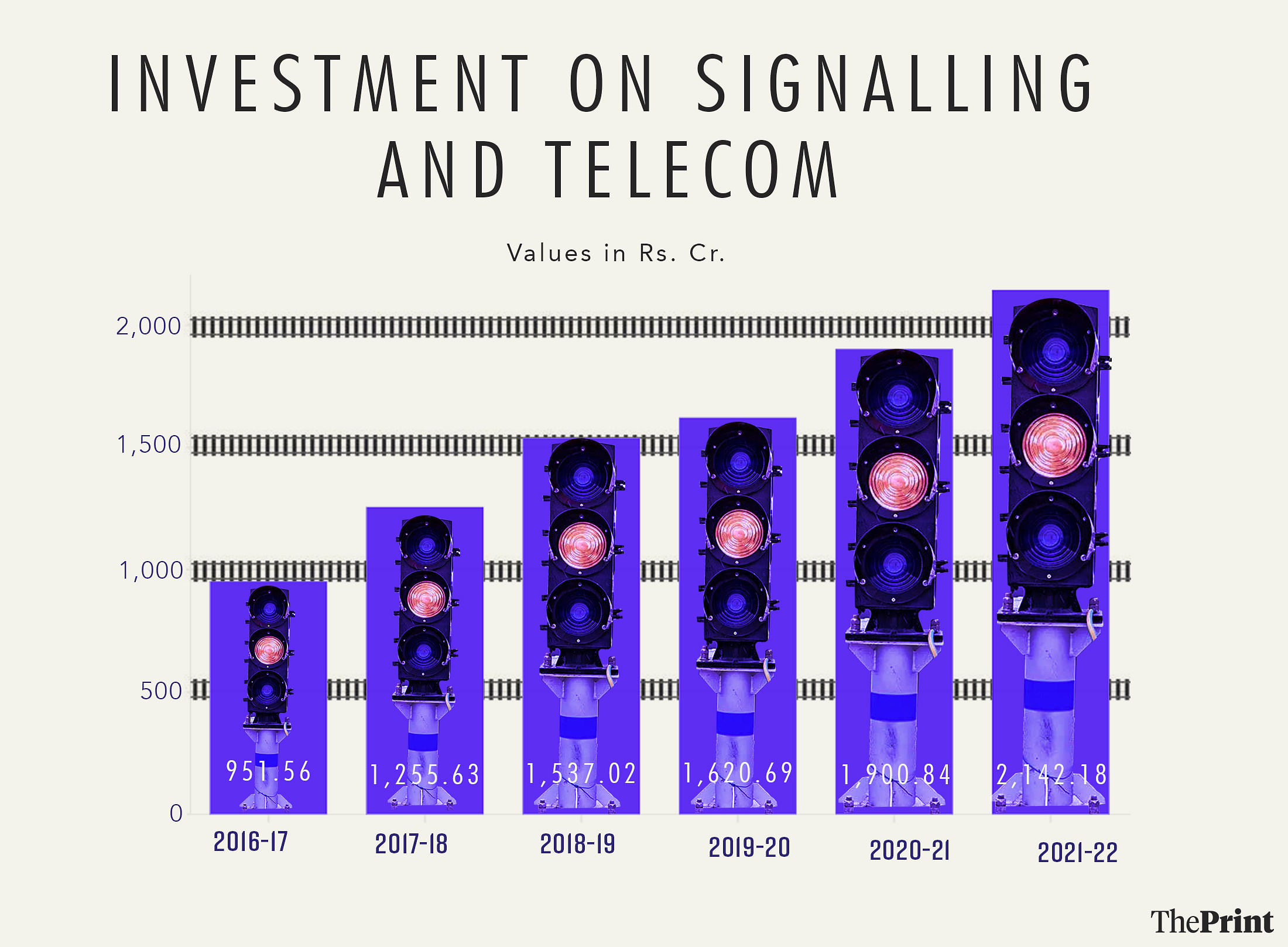
Here’s a look at the Railways’ financial performance since 2016-17 and the progress and investments it has made in infrastructure and safety works.
Also Read: Railway officers overburdened. Bring in technical experts, not IRMS to solve safety issues
Railways’ financial performance
While the budget allocation for capital expenditure has been on the rise in the past few years, the financial performance of the Railways has shown a decline in the “excess of earning over expenditure”, or surplus, in the six years from 2016-17 to 2021-22.
The annual reports show that in 2016-17, the Railways closed the year with total revenue of Rs 1.02 lakh crore from freight services and Rs 46,280.46 crore from passenger services. That year, the Railways registered an “excess” of Rs 4,913 crore
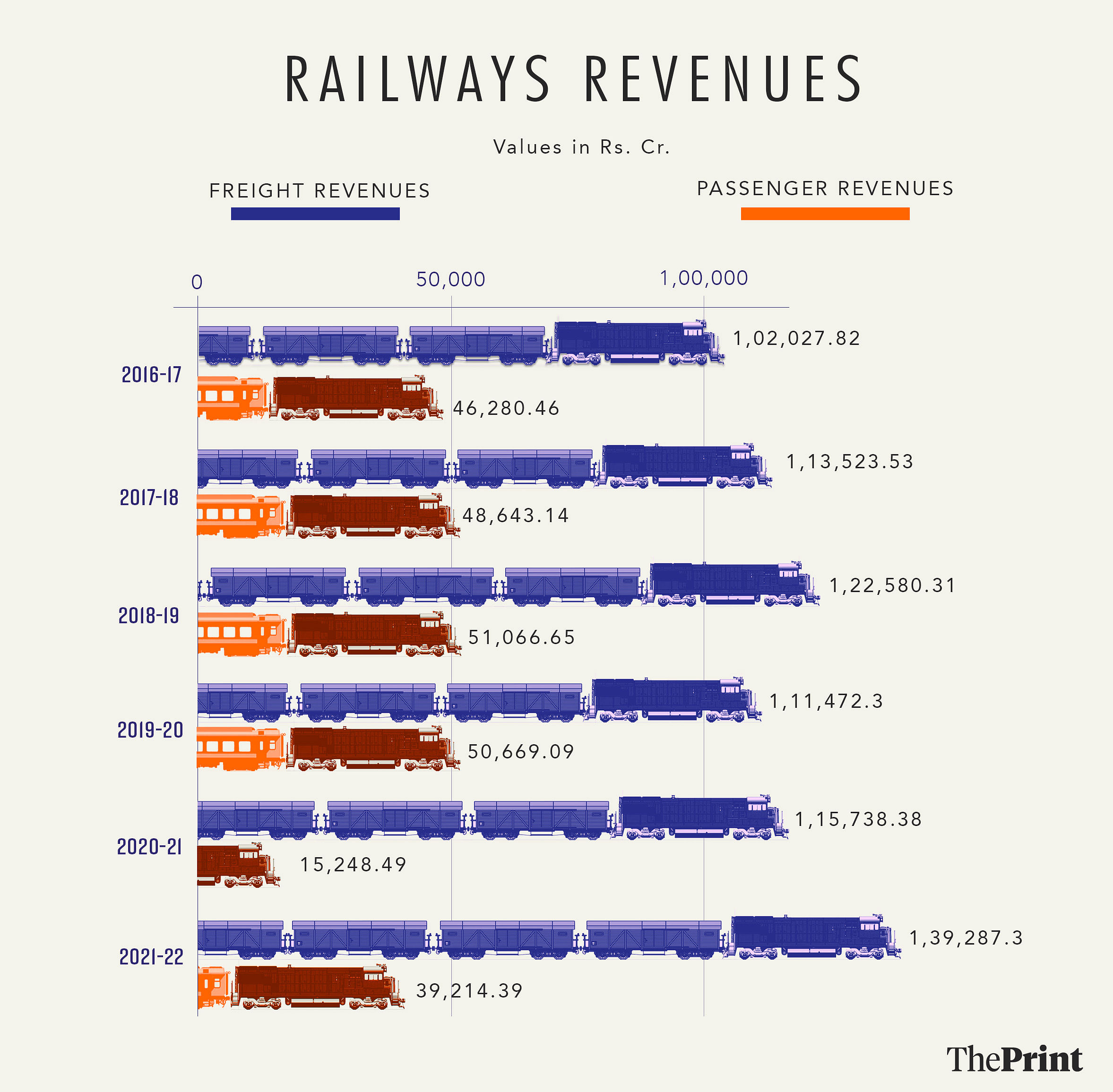
Since then, however, this surplus has been in decline, with net receipts being in the red at negative Rs 15,000 crore in 2021-22 — the year when the country was recovering from the impact of the pandemic.
“Gross traffic receipts of the Railways went up from Rs 1,40,570.52 crore in 2020-21 to Rs 1,91,206.48 crore in 2021-22. Total working expenses increased from Rs 1,36,567.51 crore in 2020-21 to Rs 2,04,606.34 crore in 2021-22. After taking into account the miscellaneous transactions, the Net Revenue Receipts were Rs (-)15,024.58 crore,” the annual report for FY22 stated.
While the annual report for the last financial year is not available, a press release issued by Ministry of Railways in April said that the Indian Railways registered record revenue of Rs 2.40 lakh crore in 2022-23, driven by a 15 percent year-on-year increase in freight revenues to Rs.1.62 lakh crore and a 61 percent year-on-year increase in passenger revenues to Rs 63,300 crore.
Also Read: How Indian Railways’ anti-collision ‘Kavach’ works & why it may not have averted Odisha tragedy
Expenditure on infra works
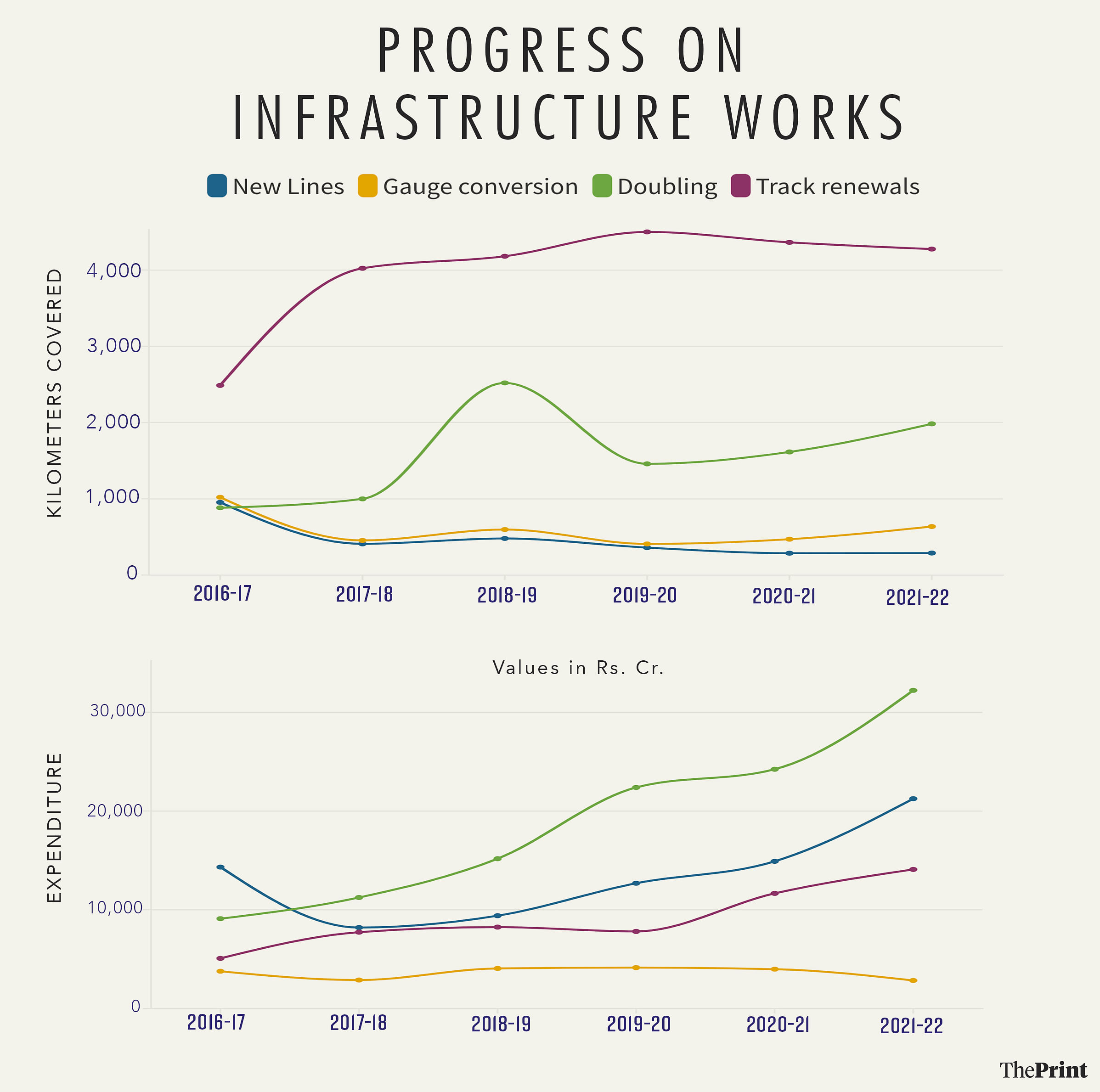
The data from annual reports show that the Railways spent nearly Rs 54,587.85 crore for about 23,829 km of track renewal, while doubling was completed on 9,455.64 km of track at the cost of over Rs 1.14 lakh crore. Likewise, it spent Rs 80,740.03 crore on construction of 2776.11 km of new lines, and Rs 21,662.35 crore on converting 3,585 km of narrow or metre gauge tracks to broad gauge.
In the six years under review, the railway ministry invested about Rs 9,500 crore in signal and telecommunications related works.
A statement issued by the ministry earlier this week showed that the expenditure on track renewal — “an important component of safety” — has grown from Rs 8,884 crore in 2017-18 to Rs 13,522 cr in 2020-21 and Rs 16,558 cr in 2021-22.
The data from the annual reports shows that while just 2,487 km of track renewal was done in 2016-17, for the subsequent years till 2021-22, track renewal was more than 4,000 km — but still less than the mandated target of 4,500 km.
A former high-ranking official at the railway ministry told The Print that with the significant increase in budgetary support in the past few years, the issue of shortage of funds has been dealt with. “The infrastructure process has gained pace and for the past few years we do not have any backlog in terms of track renewals,” the official said.
However, the Comptroller and Auditor General of India, in its 2022 report on ‘Derailment in Indian Railways’, had pointed out that allotment of funds for track renewal works declined from Rs 9,607.65 crore in 2018-19 to Rs 7,417 crore in 2019-20, and the funds allocated were also not fully utilised.
“Out of 1,127 derailments during 2017-21, 289 derailments, or 26 percent, were linked to track renewals,” the CAG report said, also voicing serious concerns over the alleged underutilisation of the special railway fund set up in 2017, the Rashtriya Rail Sanraksha Kosh (RRSK).
In response to allegations of undertilisation of the funds that were raised after the Balasore train accident, the railway ministry said in a statement last week that the RRSK’s corpus of Rs 1 lakh crore for critical safety-related works “has been fully utilised”.
In the period from 2017-18 to 2021-22, the Railways spent more than Rs 1 lakh crore on RRSK works, it said.
“The coverage of RRSK utilisation, in the (CAG) Report, is limited to three years — 2017-18, 2018-19 and 2019-20. Hence, it gives a partial picture on actual expenditure that has been undertaken on both track renewal as well as safety related works by Indian Railways. As is the practice, a detailed reply on all issues raised in this report is being sent shortly,” it had said.
In light of the Odisha train tragedy, a former Railways official said that while capex has drastically increased and the pace of infrastructure works — including track renewals — seems to have picked up pace, the ministry needs to focus on its core operations of providing safe train travel.
“So much focus on high-speed trains, launching new Vande Bharat trains and things like station redevelopment draws away top officials’ attention from the main issue of safety and infra works,” the former official told ThePrint.
The data, however, also shows that the number of consequential train accidents — major mishaps such as collisions, derailments, fire or explosion in trains, and road vehicles colliding with trains at level crossings, which have serious repercussions in terms of loss of human life or injury or damage to railway property — have come down drastically from 103 in 2016-17 to 34 in 2021-22.
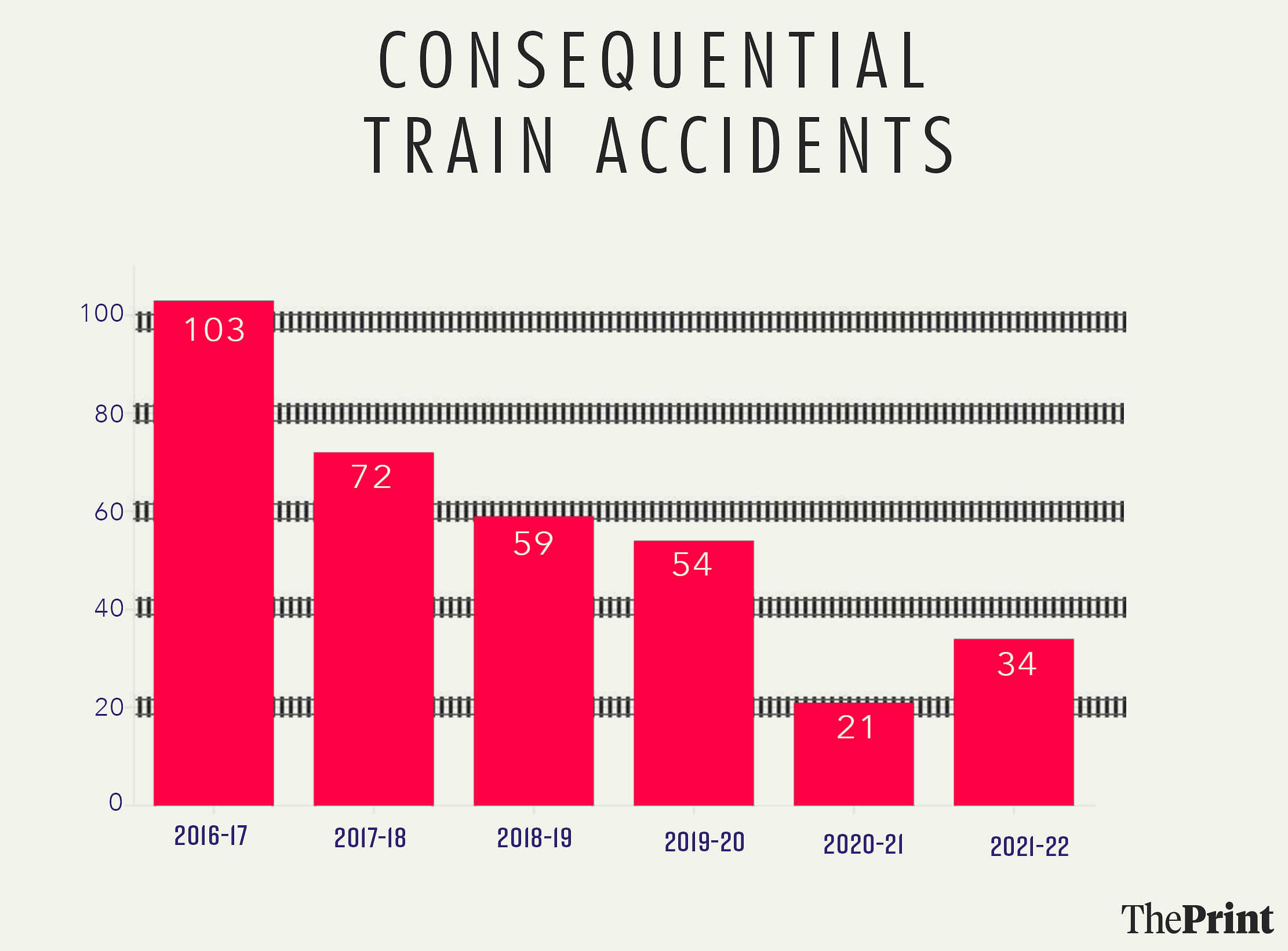
A look at operating ratio
It’s pertinent to note that despite being the largest employer in the country with over 12 lakh employees, the Indian Railways is facing a significant shortage of staff.
As of December 2022, Railways had vacancies for nearly 3 lakh non-gazetted posts, Minister of Railways Ashwini Vaishnaw had informed the Rajya Sabha in February this year.
Non-gazetted posts include a range of employment categories, including loco pilots, engineers, technicians, clerks, station masters and ticket collectors.
In addition, the former official quoted earlier said that “despite what the balance sheet may show”, the national transporter’s finances were in the doldrums until last year, when it made a record revenue of Rs 2.40 lakh crore.
The Railways’ performance, the official said, should be judged by the operating ratio — that is, how much money it spends to earn Rs 100. Before last year, the ratio had been “shown to be below 100 percent, but was not”, the official told ThePrint.
“Even a CAG report has pointed that out. I think, in 2021-22, for the first year that the Railways presented an honest operating ratio of 107 percent. And this is high largely because of expenditure that the Railways had to incur on pensions. If pensions are taken out, then the operating ratio is easily below 100,” the official added.
Indeed, the CAG also pointed it out in its report tabled in Parliament in December 2021. In the report, the CAG noted that the operating ratio of 98.36 shown by Railways in 2019-20 does not reflect its true financial performance as “with required level to appropriation to Pension Fund from Railways Revenues, the Operating Ratio would be 114.19 percent.”
However, this operating ratio, according to the government’s press release issued in April, has come down to 98.14 per cent.
“After three years, Indian Railways is able to fully meet the pension expenditures. Buoyancy in revenues and tight expenditure management have helped in achieving an operating ratio of 98.14 percent,” the government had said in that press release.
Another former railway official saw this development, as well as the Railways’ record revenue in 2022-23, as evidence of the national transporter being on the right track.
“The freight loading is picking up and so are the revenues from freight services. If we can keep it up…the Railways’ operating ratio will improve,” the official said.
(Edited by Uttara Ramaswamy)
Also Read: Odisha train accident: Official flagged ‘serious flaws in signalling system’ in February



